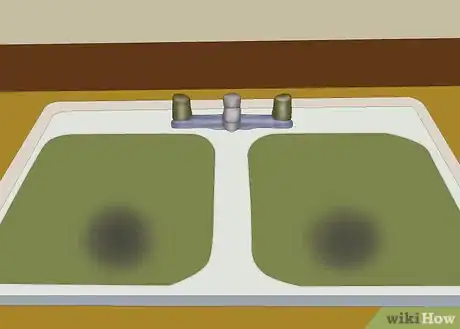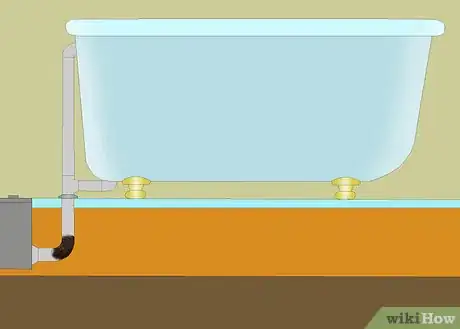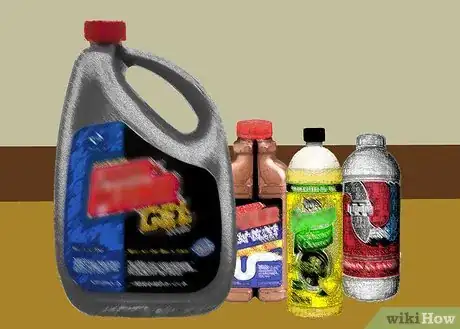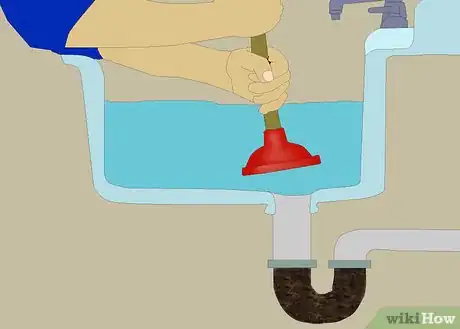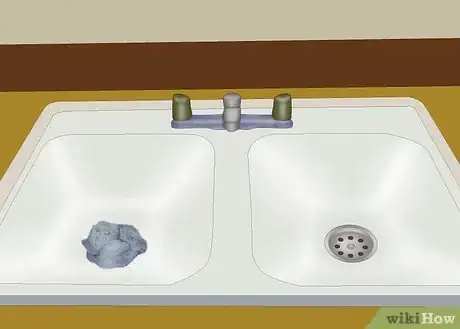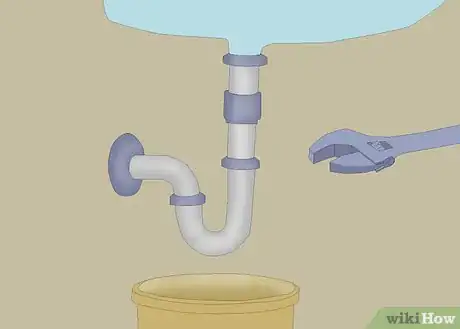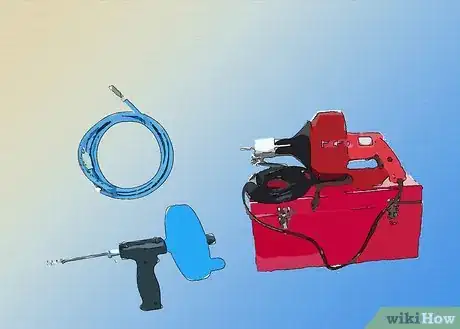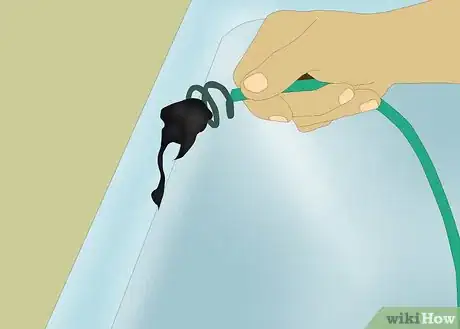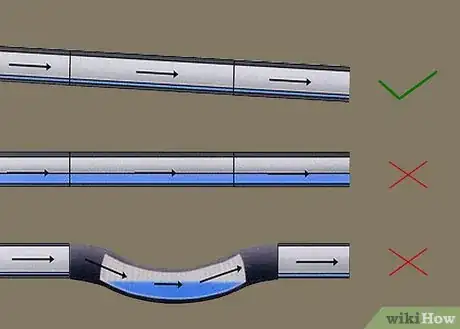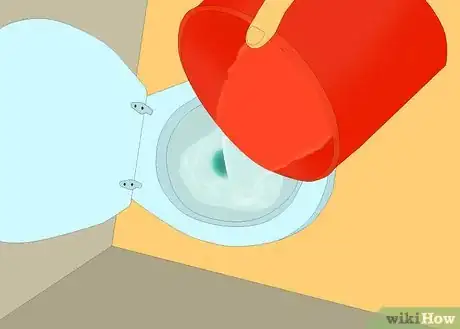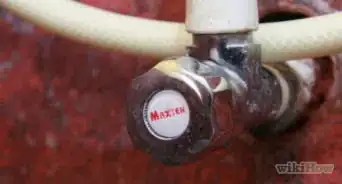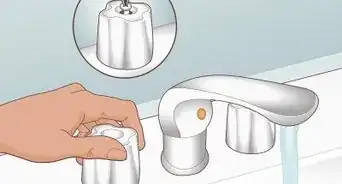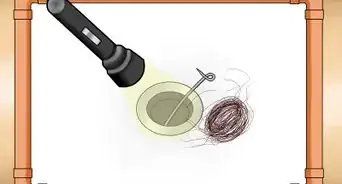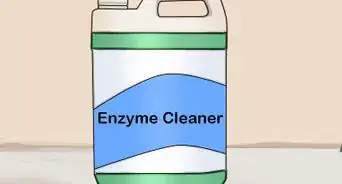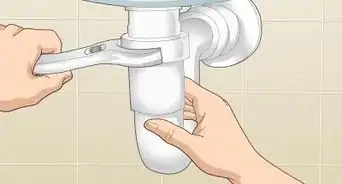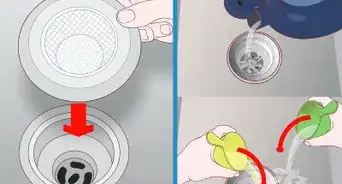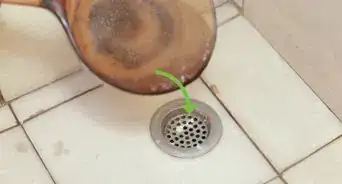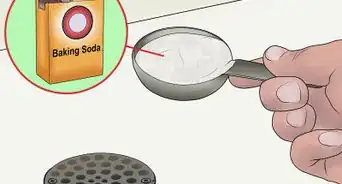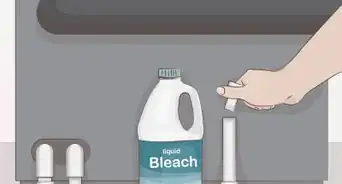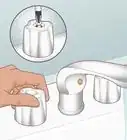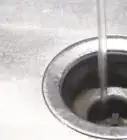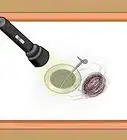This article was co-authored by Chris Willatt. Chris Willatt is the owner and founder of Alpine Maids, a cleaning agency in Denver, Colorado started in 2015. Alpine Maids has received Angie's List Super Service Award for three years in a row since 2016 and has been awarded Colorado's "Top Rated Local House Cleaning" Award in 2018.
wikiHow marks an article as reader-approved once it receives enough positive feedback. In this case, 100% of readers who voted found the article helpful, earning it our reader-approved status.
This article has been viewed 949,709 times.
When the water flow is clogged in your kitchen drain, see if you can fix it yourself before calling out the plumber.
Steps
-
1Realize that when water does not run through your drain, it is because there is a bunch of junk and trash clogged up in one of the pipes. The clog could be anywhere in the drain pipes, not just limited to your kitchen. Although rare, it can even be in the vent pipe leading to the roof; such blockages usually cause slowly draining pipes rather than completely blocked pipes (just like slowly flowing gasoline from a gas can when the vent is closed).
-
2Hair clogs. For bathtub, shower and wash basins, an inexpensive barbed plastic dipstick may do the trick (e.g. “Zip-It”). These dipsticks are often limited use as the barbs are easily broken.[1] [2]Advertisement
-
3Try a plunger. Liquid drain cleaners usually contain lye or other hazardous, caustic chemicals, and sometimes damage older types of pipes, and are toxic to fish. There are, however, a few earth-friendly enzymatic powders available (but they usually take 24 hours or so to work, and often are ineffective on stubborn clogs).[3]
-
4Keep at it. Plungers can work on the upstroke or the downstroke. Plunging down increases the pressure above the clog and forces it down the drain (while breaking it up), on the upstroke the pressure above the clog becomes lower than the pressure below the clog (which then may break apart and come up into the bottom of the sink, where you may collect it and dispose of it in the trash).
-
5Seal off secondary openings. If working on a double kitchen sink with two slowly moving or clogged drains, either close up one side with a wet rag — or use two plungers at once (perhaps with a friend's help), pushing down and pulling up together. On a bathroom sink with an overflow hole, seal the hole with a wet rag (or just your hand) while plunging the drain. Failure to block any secondary openings results in a significant loss of pressure from the plunger, likely leaving the clog in place, and may cause water to eject from the opening. If you aren’t dislodging the clog with a plunger, and the secondary openings are sealed off, try adding a little water in the sink around the plunger, as this may help to seal the connection to the sink/drain. If the plunger still doesn’t work, the clog may be past the sewer air vent to the roof, and the force of your plunge is simply going up the vent.[4]
-
6If the plunger doesn't work, you may have to snake it.[5] But first put a bucket under the trap below the sink, and remove the trap by unscrewing the connectors. (Hopefully you haven’t used any caustic chemicals on the clog. If you have, be extremely careful and wear protective gloves, goggles & clothing.) Clear the trap of any clogs. If the water drained from the sink when the trap was removed, and the trap wasn't clogged, then the problem is further down the drain. This is almost certainly the case in a double sink where both sides are clogged (since each side usually has its own trap).[6]
-
7Buy a "snake" (also known as a drain cleaning auger).[7] Typical sizes for home use range from 15−50´. 25´ is usually more than enough. Some are manual, some electric, some are hybrids, and others are automatic. Hybrids can be hand cranked, or attached to an electric hand drill. Unless you need to work on drains frequently, it’s probably best to start off with an inexpensive manual snake. In most cases, a drill attachment is over-kill, can get in the way, and becomes one more item which may require cleaning.
-
8Insert the snake into the drain pipe where you removed the trap (easier than from the drain in the bottom of the sink), and when you meet resistance, rotate the snake clockwise. If it begins to move forward easily again, you have likely just hit a turn in the pipe. If not, continue to turn and gently push forward to cut through and clear the clog. Never jam a snake hard as this is unlikely to clear the clog, and may damage the snake.[8]
-
9When you retrieve a snake from the pipe, be prepared for it to be covered in the most vile, black, smelly sewer-line sludge (even for kitchen drain lines). Snakes are springy by nature; when the tip of the snake comes out, make sure it doesn’t have an opportunity to whip around, or you and the surroundings will get sprayed with sludge. Cussing will follow.
-
10Sometimes clogs can be more easily approached with a snake from the air vent on the roof. Shorter snakes may be unable to reach the clog from the roof, however.
-
11If the snake doesn't reach the clog, look for a clean out (unscrew a plug in the drain pipe in the basement) further down the drain where the snake may be inserted.
-
12Slow drains. A plugged air vent will cause sinks to drain slowly. If the snaking the drain doesn't help (particularly where the sink drains, but very slowly), an air vent obstruction may be the cause. You may need to snake out the air vent from the roof.
-
13Sometimes there can be a problem with the slope of the drain pipes (although plumbing codes are designed to prevent this, not all pipes are up to code). Check the visible portion of the drain pipe (in the basement) for sagging drain pipes. It may help to add pipe hanging straps to ensure that there is a steady downward slope in the direction of desired flow.
-
14Although plungers are a standard way to clear a clogged toilet, they can be messy to clean afterward. Time and water alone can often clear a clogged toilet. Usually the problem is a combination of feces and toilet paper. Over time, the water logged toilet paper softens and breaks apart. Put about two gallons in a bucket and pour water directly into the bowl. The idea is to pour the water as quickly as possible, but not so forcefully as to cause splash-out. This can sometimes create more force than a flush alone might accomplish. If nothing seems to move much, wait about a half-hour before trying again. Repeat as necessary. This method is almost always effective, in time, but may take several hours to work. Patience is key. If you don’t have the time, a plunger will usually do the trick. Failing that, you may want to buy a special toilet auger, which differs from a standard snake in that it is short, and attached to a 3´ rod.
-
15If this is your kitchen sink, and it has become plugged from running the garbage disposal. If you have already tried a snake (see above) and keep getting food, but you cannot unclog the drain, what I have done, is unhooked the line feeding the ice-maker, or dishwasher, attach a 1⁄4 inch (0.6 cm) hard clear flexible tube on that connection (about a 10 foot piece) then unhook your drain pipe from the wall/floor, and fish the tube as far down the pipe as you can, once it stops going down the pipe, put a catch can under the opening to catch any back flow of water/food. turn on the water, and push the tube back and forth.. If you get the tube down to the food block-up, it should blast the junk out of the way. And the best part is you don't use any chemicals. (someone feel free to rewrite this so it makes sense, and fix typos and spellings)
Community Q&A
-
QuestionMy double sink was completely clogged. A plumber snaked it so the right sink drains well, but running the disposal in the left sink makes water back up into the right sink. What is happening?
 Community AnswerThe disposal is forcing water down the drain faster than the drain can handle. Either the drain still isn't clear enough, or the disposal isn't plumbed in right.
Community AnswerThe disposal is forcing water down the drain faster than the drain can handle. Either the drain still isn't clear enough, or the disposal isn't plumbed in right. -
QuestionHow long do I run the water after I removed the clog?
 Community AnswerRunning the water (hot and on high) for two minutes should be long enough to confirm the clog is cleared. The heat may help wash loose oil/grime on down into the sewer system.
Community AnswerRunning the water (hot and on high) for two minutes should be long enough to confirm the clog is cleared. The heat may help wash loose oil/grime on down into the sewer system. -
QuestionHow do I stop a leak under the kitchen sink?
 Community AnswerFirst, see if the leak is coming from the incoming pipe or the drain pipe. If it is the drain pipe, find out if the leak is coming from a hole in the pipe or a joint. Replace or patch a hole in the pipe, and tighten or replace a leaky joint. If the leak is coming from the incoming pipe, your best bet is to call a professional to fix it - trying to fix it on your own risks serious water damage.
Community AnswerFirst, see if the leak is coming from the incoming pipe or the drain pipe. If it is the drain pipe, find out if the leak is coming from a hole in the pipe or a joint. Replace or patch a hole in the pipe, and tighten or replace a leaky joint. If the leak is coming from the incoming pipe, your best bet is to call a professional to fix it - trying to fix it on your own risks serious water damage.
Warnings
- make sure to wear your safety goggles or glasses, especially when using any kind of chemicals. gloves and long sleeves are also a good idea⧼thumbs_response⧽
- Be aware that when you pour dangerous chemicals down your sink, often you or someone else has to snake that line. This means deadly chemicals will come back out, dripping from the metal snake, and can get all over you and the kitchen. Act with caution.⧼thumbs_response⧽
- know your pipes, chemical drain cleaners are usually very caustic and will have a detrimental affect on metal pipes such as cast iron.⧼thumbs_response⧽
Things You'll Need
- Plunger(s)
- Trashcan (to dispose of gunk)
- Friend (for double sink)
- Hand (for bathroom sink)
- Bucket (for plunger backup)
- Drain Cleaning Auger (if bucket way doesn't work)
- Pipe Hanging Straps (to help with pipe "sloping")
References
- ↑ Chris Willatt. House Cleaning Professional. Expert Interview. 1 July 2019.
- ↑ https://www.wisebread.com/10-really-easy-ways-to-unclog-drains
- ↑ https://www.youtube.com/watch?v=VCd0d6hjsDc
- ↑ https://www.todayshomeowner.com/video/how-to-unclog-a-sink-drain-fast/
- ↑ Chris Willatt. House Cleaning Professional. Expert Interview. 1 July 2019.
- ↑ https://www.plumbingsupply.com/how-to-clean-a-sink-trap.html
- ↑ Chris Willatt. House Cleaning Professional. Expert Interview. 1 July 2019.
- ↑ https://www.familyhandyman.com/plumbing/drain-repair/how-to-clear-clogged-sink-drains/
